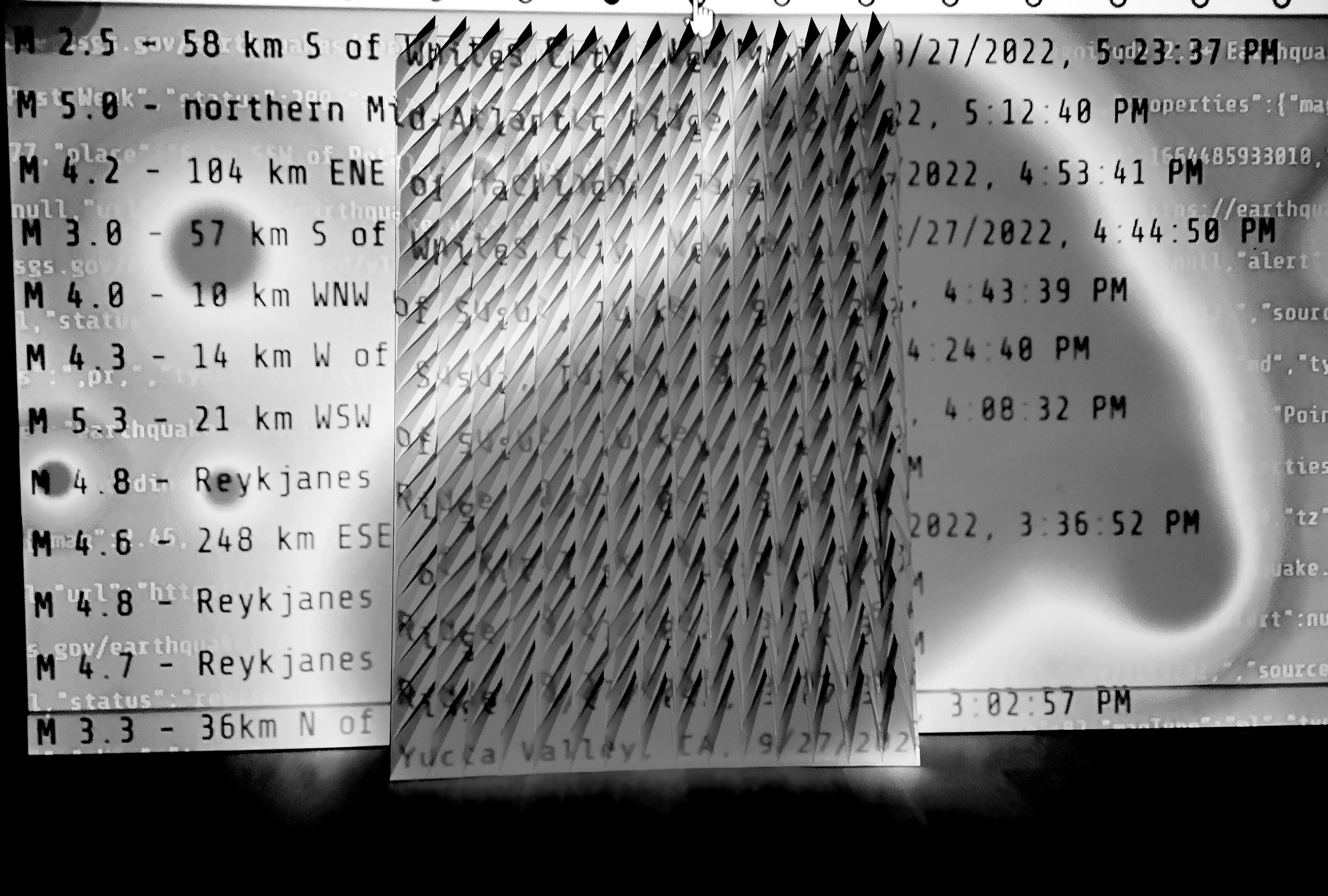
Re-prototyping / Faults 2022 The relation between material system and design model
projects by Syntia
Re-prototyping / Faults 2022

Earth’s lithosphere comprises a number of large tectonic plates which has been slowly moving since about 3.4 billion years ago. Earthquakes, volcanic activity, mountain-building, and oceanic trench formation occur along these plate boundaries where the plates meet, their relative motion determines the type of plate boundary: convergent, divergent, or transform. The relative movement of the plates ranges from zero to 10 cm annually. For much of the last quarter century, the leading theory of the driving force behind tectonic plate motions envisaged large scale convection currents in the upper mantle, which can be transmitted through the asthenosphere. Seismic tomography, two- and three-dimensional imaging of Earth’s interior, shows a varying lateral density distribution throughout the mantle. Monitoring the conditions of seismic events concludes analysis of processes in the deep subsurface that lead to seismicity, subsidence and earthquakes. In high seismic risk areas where the main goal of networks is future seismic risk mitigation, strong-motion recordings play an important role.
In process of organizing and curating our first three day event and hackathon, YEAR0: RECLAMATION in Stolzenhain, we found a broadband seismometer that had been installed before the USSR closed the Nuclear Warhead Storage facility and a military base in 1991. It isn’t accessible anymore but used to record wide range of frequencies that motivated us looking into seismic event monitoring in this area and collecting the geophysical data of triggered activity from seismographs around the world. I’ve built a software for monitoring earthquakes based on the data from the United States Geological Survey (USGS). It sends notifications with the latest available parameters about the magnitude, location and significance of the earthquakes and visualizes earthquake frequency by location using a heatmap layer. It is work in progress to make it publishable and subscribe to the events in real time. It renders a range of colors to represent the density of points and highlight areas where earthquake frequency is high and many points are clustered closely together.
Owing to friction and the rigidity of the constituent rocks, the two sides of a fault cannot always glide or flow past each other easily, and so occasionally all movement stops in the regions of higher friction along a fault plane. Stress builds up when a fault is locked, and when it reaches a level that exceeds the strength threshold, the fault ruptures and the accumulated strain energy is released in part as seismic waves, forming an earthquake.
A fault often forms a discontinuity that may have a large influence on the mechanical behavior as strength, deformation of soil and rock masses in. Divergent boundaries can create massive fault zones in the oceanic ridge system where spreading rates of adjacent ridge blocks are different. These fracture zones are a major source of submarine earthquakes.
This installation wall piece represents a fault that passes through different levels of the lithosphere. The level of a fault’s activity can be critical for locating buildings, tanks, and pipelines and assessing the seismic events to infrastructure and people nearby.
The relation between model of design and prototype gains importance as our understanding and relating of material systems to their simulated abstract models replaces complex mechanical assemblies with computational feedback and control.
Much of architecture’s complexity lies in its cultural context and the reclamation due to its scale and density of the built environments. Exploiting system dynamics and non-linearities evolves through embedded non-digital computational capabilities in physical constructs that provide robustness and control that is immediacy for feedback and ability to analyse the overall system behaviour and performance. Models and abstraction layers play a crucial role in the development and understanding of such processes.
The key capacity in the mode of the design of spring-based modelling in which the relationships of geometry and behaviour can be gradually tuned are characterisations of topology and behaviour of forces that allow defining different compositions and form binding.


Faults 2022, video installation by Anderson Kaltner and wall sculpture at group exhibition OBJEKT4000
Grid structures
The emergence of gridshell structures is the major step in the development of complex shapes in Architecture, Engineering and Construction. Frei Paul Otto was a German architect and structural engineer noted for his use of lightweight grid structures, such as the roof of the Olympic Stadium in Munich for the 1972 Summer Olympics.
Gridshells require knowledge in 3D geometry, form-finding techniques, non-linear behavior, large-scale deformations, permanent bending stresses and tools for their design. Computing tool based on Rhinoceros & Grasshopper introduces shape driven design for NURBS and polygon mesh surfaces that gives structural analysis of the resulting grid.


Faults 2022, video installation and wall sculpture by Syntia for group exhibition “Reclamation”, OBJEKT4000
Material Flexibility for Structural Rigidity
Composite materials like glass fiber reinforced polymer (GFRP) are suitable for replacing wood with both resistance and bending abilities. Thus, the structure’s stiffness derives from its geometric curvature and not from the material’s intrinsic rigidity.
The way of design with a given outline approach outputs the final shape as a result of a form-finding process driven by the support of a grid input data.
Folded structures
Due to the geometric logic of the force flow, robust structures often resist the applied external loads through their geometry rather than through accumulation of materials. The architect Eladio Dieste added to this approach: “There is nothing more noble and elegant point of view than this, resistance through form”. A static analysis of a distribution of the principal stress in folded plates shows that it follows a pattern: There is a local accumulation of high stresses along the edges of the folded structure. The versatility of this structural principle enables the design structures that explore the threshold between the architecture and engineering disciplines.

Sculpture by Olga Bogatischeva for “Year 0: RECLAMATION” Objekt4000

Mural by Antony Reznik for “Year 0: RECLAMATION” Objekt4000
Re-design of Natural Structures
Natural structures give impressive examples of structurally optimized geometries. Nature has developed a great variety of lightweight structures, resulting from optimization procedures running over billions of years. The methods of structural optimization are used to clarify the basic characteristic of their load-bearing behavior and to develop structural geometries with the same efficiency.
One example is Ernst Haeckel’s demonstration of a variety of shapes in microscopic structures, such as diatoms, with structural shapes depending on the overall geometry as well as the loading conditions of the structure.


Work by Enzo Dinolfo, graphic design for “Year 0: RECLAMATION” Objekt4000
Parametric modeling
Parametric modeling is the integration of programming techniques into the design process where the design team can manage highly complex design tasks with high precision and generate design variations with elaborative models and changeable values in real time. It is mostly covered by any object-oriented architectural design software (CAAD). The categorisation of the obtaining insights covers: Variations of the design drivers and phenotypes; dependency relations and influence; Identification of design goals and constraints; near-linear correlations between certain objective values. By looking at design processes not as a singular event of analysis but as continuous development of these measures the concept of enhanced computational design is apparent.

Model design for the wall sculpture Faults 2022 installation by Syntia
Generative design
The generative design emergence is followed by parametric modeled structure that cannot be predicted exactly by reviewing the elements of the program. It is typical for agent-based systems (swarm behavior) and recursive programs.
In computational design designers will make investment-reward to the operations of intermediate constructive elements to achieve desired outcome. With such a generative program our long term objective and challenge is to create a computation environment which provides a learning curve for designers with little or no programming experience to see the immediate practical results, but also encourage learning imperative programming to understand the characteristics of the tools and languages, introduce advanced computing concepts and overcome abstraction barrier.